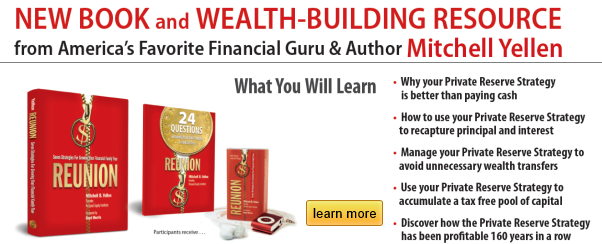The Infinite Banking Concept: Be Your Own Bank
Using The Infinite Banking Concept to finance purchases without lending from banks.
You probably dont sit around calculating how much interest you pay to banks and other lenders each year, but chances are you have financed large purchases, such as homes, education, cars and major appliances
The interest you pay to banks can add up
That is exactly what R. Nelson Nash had in mind when he pioneered the Infinite Banking Concept. In essence, Infinite Banking, and other similar systems adapted from Nash’s original idea, involves paying into a whole life insurance policy with an insurance company that allows policy holders to take loans collateralized on their individual policies.
How the Infinite Banking Concept works
Infinite Banking and other individualized banking systems rely on participating
“Generally, we try to fund most of the money into it in the first five years,” Tom McDermott, president of Asset Protectors & Advisors Group, said. “The longer you can allow it to accumulate, obviously, the more you can pull out for retirement savings, the more you can pull out for larger items.”
After the capitalization phase, the policy becomes self-supporting; the returns on the policy at that point will be enough to cover the premiums. The annual dividends are based on how well the insurance company did that year. Insurance companies must invest the premiums received “in order to produce the benefits that are promised,” Nash wrote.
Through the use of a paid-up additions rider, policy holders benefit from having their dividends reinvested into their policy, thus increasing the value of their policy and subsequent death benefit.
Policy holders are able to borrow up to 100 percent of the cash value of their whole life policy at any time with no tax penalties. A policy holder “outranks every potential borrower in access to the money that must be lent,” Nash wrote.
With this structure in place, policy holders are able to essentially act as their own personal bankers. They can loan themselves money from their own life insurance policies, and the interest payments go back to their own accounts.
People who participate in individualized banking are able to borrow money from—and repay—themselves when financing major purchases, rather than relying on and paying interest to banks and other outside lenders.
“Your average American family is not saving money...at the same time, they’re spending approximately 34.5 cents on every dollar in interest to finance their lifestyle through banks and different finance companies,” David Kane, president of the benefits division at York International, said.
By depositing cash into a life insurance policy rather than using it for a major purchase, investors retain the ability to earn interest on that cash. Further, by borrowing from their own life insurance policy, they avoid having to spend that 34.5 cents per dollar on outside financing, and can instead pay that to their own policy.
The borrowed money can be used to finance any purchase, whether or not a lender would typically grant a loan for it. The policy holder, as banker, gets to set the loan requirements.
“You are totally and completely independent from all other sources of financing,” Rebecca Rice, owner of Rebecca Rice & Associates, said. “You have control of your own banking system and you’re able to control the amount of money that goes into your bank.”
Policy holders must make sure that they pay back any loans they take out. If they don’t, the system of growing the policy’s value will fail.
People who follow through on utilizing the insurance policy as a bank are able to supercharge the returns guaranteed by the policy while financing things they would have financed anyway. The difference is that all the interest payments go back to the policy, not to a bank or other lender.
“The Infinite Bank is really like a complete financial system. It will provide money for your lifestyle, for your retirement and for your heirs,” Kane said. “It works well in all phases of wealth.”
The advantages
Perhaps the most obvious advantage of the Infinite Banking Concept is that it offers life insurance coverage—something most people need anyway. Life insurance is a low risk investment; there are guaranteed returns, and life insurance companies are noted for their longevity.
There are also tax benefits. “In a properly structured life insurance program, if you borrow the money out of the policy, the proceeds are tax free,” McDermott said. “As long as you don’t lapse the policy, no taxes are due. When the death benefit is paid, it is paid income tax free, minus the withdrawals. We structure these programs so that the income stream is tax free through
In addition to providing capital for borrowing, policies can also provide a stream of retirement income for policy holders. There are no age limits on policy withdrawals.
“This is the front of the wave for retirement planning,” McDermott said. “Setting up something like an Infinite Banking plan...allows you to save for retirement planning and [know] exactly what your tax exposure is going to be when you start pulling the money out. And if you pull it out correctly, you’re going to have zero tax exposure.”
Insurance policies are also safe from exposure to litigation and creditors. “Insurance policies are protected from...taxes, creditors, litigation, things like that,” Steve Sappington, co-founder and registered principal of TWM Group, LLC, said. “We have, for example, a lot of doctors who use this Infinite Banking Concept...because it shelters assets.”
In addition to being safe, individualized banking is flexible. Policy holders can borrow money and use it for purchases for which financing is usually hard to come by, such as foreign real estate. Policy holders can even become lenders themselves, borrowing money to lend it to other people in order to earn further interest.
People who use the Infinite Banking Concept can use their policy in a variety of ways without turning any money over to a bank or other lender at any time. “It’s really phenomenal,” Rice said.
The disadvantages
Still, it is by no means a perfect system. It typically takes several years for policies to grow to the point that the returns equal the costs of the premium, and for there to be a significant enough value in the policy to warrant borrowing from it.
The initial stages of individualized banking are analogous to starting a small business; there are a few years where money is spent before any money comes in. In addition, policy holders must be dedicated to building up the value of their policies.
“Just plan on really funding that policy well for seven years, then you’re going to be able to do some really nice things as a result from that,” Sappington said. He compared the initial stages to a jet taking off. A jet uses a lot of fuel to take off but becomes much more efficient after the initial surge of fuel use.
In addition to building up their policies, policy holders must be dedicated to paying back loans, though there is certainly more flexibility involved, since policy holders are paying themselves back. If unforeseen circumstances arise, policy holders can change their repayment schedule as necessary, rather than worrying about
People who want to use the Infinite Banking Concept will need someone familiar with it to help them set it up, and not all insurance brokers are aware of the system.
Those interested in Infinite Banking will need to do research to make informed decisions. Fees, commissions and the percentage of the premium that goes toward building the account’s value vary by company, and there are many ways to structure whole life policies.



